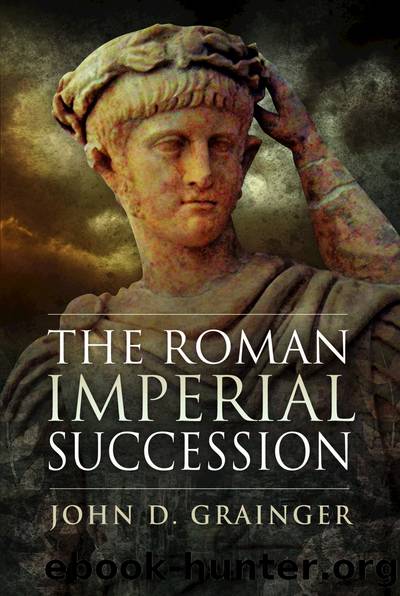The Roman Imperial Succession by John D Grainger;

Author:John D Grainger; [Grainger;, John D]
Language: eng
Format: epub
Tags: History / Military / Ancient
ISBN: 9781526766045
Publisher: Casemate
Published: 2020-06-29T00:00:00+00:00
The Licinian Near-Dynasty
Trebonianus Gallus (251â253). (Sailko via Wikimedia Commons)
Gallienus (253â268).
Aemilianus (253).
Valerian (253â260).
The Gallic Empire
Postumus (260â269).
Victorinus (269â271).
Tetricus II (271â274). (CNG via Wikimedia Commons)
Chapter Ten
The Consequences of Gordian (1): Successful Emperors
One of the results of the events of 238 was to emphasize once again the possibility that a man might, by rebellion, make himself emperor. The events of 68â69 and 193 had already done so, and more recently in Syria Elagabalus had successfully seized power by rebellion.
A distinction must be made between the rebellions of Elagabalus and Gordian against the actions of other emperors in killing or acting against an emperor and taking his place, as Maximinus and Macrinus had done most recently by coup dâétat. A rebellion was mounted away from the court and required an army to march on the capital. The most successful recent example was Septimius, but Gordian clearly intended to do the same; ironically, one result of his rebellion was that the Emperor Maximinus ended up in the posture of a rebel marching on the city.
The events of 238 were so widespread, involved so many groups and were so widely broadcast that the possibilities became much more appreciated. This was clearly one of the reasons why the next half-century saw a great number of pretenders and rebels to add to the confusion generated by the rapid turnover of 238, the âyear of seven emperorsâ. Yet this was a time when the Empire went through an agonizing and extended period of foreign invasion and monetary inflation, and the rebels and pretenders were all part of that overall problem; at once cause, consequence and solution. The confusion was such that it is not too much to say that the Empire had collapsed.
The rebels are often pushed aside or out of consideration, so that the main story of the âlegitimateâ emperors is usually that which is told, and it must be said that story is certainly complex enough even without the rebels. Here, however, rebellion is central to the concerns of this study, and so we shall consider the rebels as a separate group in the next chapter. Previously (in Chapters 6 and 8) they have been included in the main account, but they are so numerous in the mid-third century that they deserve a more detailed discussion. This chapter, therefore, will look at the âlegitimateâ emperors â those generally supposed to be so, that is â and their modes of succession.
From 238 to 284 a superficial consideration of Roman politics might suggest that it was the Roman army that determined who should occupy the imperial throne. The emperors were certainly usually proclaimed by their soldiers, who had often murdered their imperial predecessors, hence the term âmilitary emperorsâ or âmilitary monarchyâ which is sometimes used for this period, but such a description is not necessarily accurate. After all, the basis of Augustusâ power, and hence of every later emperor, was control of the army.
Also, the revival of senatorial influence during 238 cannot be ignored. After all, influence was the only power ever wielded by the Senate once the imperial system had been installed.
Download
This site does not store any files on its server. We only index and link to content provided by other sites. Please contact the content providers to delete copyright contents if any and email us, we'll remove relevant links or contents immediately.
The Radium Girls by Kate Moore(11930)
100 Deadly Skills by Clint Emerson(4843)
Rise and Kill First by Ronen Bergman(4705)
The Templars by Dan Jones(4629)
The Doomsday Machine by Daniel Ellsberg(4420)
The Rape of Nanking by Iris Chang(4139)
Killing England by Bill O'Reilly(3953)
Hitler in Los Angeles by Steven J. Ross(3901)
Stalin by Stephen Kotkin(3883)
12 Strong by Doug Stanton(3510)
Hitler's Monsters by Eric Kurlander(3269)
Blood and Sand by Alex Von Tunzelmann(3140)
The Code Book by Simon Singh(3077)
Darkest Hour by Anthony McCarten(3072)
The Art of War Visualized by Jessica Hagy(2945)
Hitler's Flying Saucers: A Guide to German Flying Discs of the Second World War by Stevens Henry(2716)
Babylon's Ark by Lawrence Anthony(2622)
The Second World Wars by Victor Davis Hanson(2485)
Tobruk by Peter Fitzsimons(2447)
